A Birdy New Year!
This article is about the parrots we have, not the ones we wish we had. Here in Germany, we don’t wish we had. Because we never have had. But now that we do have, and while we may or rather should wish we had not, we might as well roll with the punches and accept that we have.
Yes, Germany has parrots, or parakeets to be more precise. Unlike North America, Germany has never had naturally occurring psittacines that went extinct, and the one we have is a true and complete invasive alien introduction. We are therefore talking true evil here when we are talking about Germany’s Rose-ringed Parakeets.
The Rose-ringed Parakeet naturally occurs in two isolated areas: a thin strip across Africa just south of the Sahara, and south Asia where it is mostly found in India with smaller ranges in adjacent countries. It is commonly kept in captivity and has therefore established many feral populations world-wide originating from escaped / released cage birds. This is what happens when people choose their pet birds on visual factors alone without taking vocalizations into account. Very stupid thing to do.
The Rose-ringed Parakeet’s European (=feral) range is surprisingly coherent for an introduced bird that is dependent on large metropolitan areas, and the species occurs in very decent numbers from UK’s London throughout the Netherland’s large cities all the way up along the Rhine to Germany’s Heidelberg. There are other more isolated populations, e.g. in Hamburg, Berlin, Rome, Paris, and Barcelona. With 7,500 birds (1,500 breeding pairs), the German population is still rather small compared to the numbers the parakeets have built up in the UK or the Netherlands, where the populations range in the 10s of thousands. Birders visiting Germany and wishing to connect with the species might therefore be happy about a few sites, and I have thus summarized the best areas for finding Rose-ringed Parakeets around my stomping grounds, the Heidelberg-Mannheim metropolitan area, below.
Where to find Rose-ringed Parakeets in the Heidelberg-Mannheim metropolitan area
Okay, they are not exactly easy to miss wherever you are so long as the place has older trees. But it does help to know where they hang out most frequently to optimize the little, precious time birders usually have in cities. Here are a few of the hot-spots:
Heidelberg
- Main roost (currently) at central railway station, with sometimes more than 700 birds. The roost used to be in front of the “Stadtwerke” (the high chimney with breeding Peregrine Falcons) along Kurfürstenanlage a few hundred metres to the east, but the birds switched to the train station in January 2011. If you find yourself at the railway station early morning before sunrise and all is quiet, just follow the bird noise and walk along the Kurfürstenanlage towards the inner city.
- University campus at Im Neuenheimer Feld, particularly in the north (turn off Berliner Straße and into the street Im Neuenheimer Feld) and south (park at the zoo, see below). The campus is actually one of the best birding spots in Heidelberg (along with the old cemetery, see below), which just goes to show how crappy the city is for birding. You’ll get a decent selection of common garden birds and a few finer ones, e.g. Common Redstart and Fieldfare.
- Heidelberg Zoo to the south-west of Neuenheimer Feld, all over the place but most often at the seals enclosure and the adjacent kiosk. The zoo has a small colony of genuinely wild Grey Herons (watch them compete with the seals for the fish!), and the White Storks are also wild and countable despite breeding at the zoo.
- Along the Neckarwiesen, a park dominated by meadows along the northern shore of the river Neckar. The local flock of geese (mostly Pink-footed, Swan Goose) is not “countable” while the Egyptian Geese and Ruddy Shelducks that occasionally turn up are.
- The old cemetery next to the tram station S-Bahnhof Südstadt/Weststadt, one of Heidelberg’s best birding destinations if that is your thing.
- Throughout Südstadt and Rohrbach in lower numbers, but frequently e.g. in Rohrbach south of Freiburger Straße.
Mannheim / Ludwigshafen and surroundings
- Main roost is the triangular parking lot at Leopoldstraße in Ludwigshafen, with around 850 birds. It used to be the parking area at the BASF plant, intersection Brunckstraße and Rottstückerweg.
- Luisenpark Mannheim is a very good place for them. That’s all the info I have got about Mannheim / Ludwigshafen, but they are common there throughout.
- Schloßpark Schwetzingen (“palace gardens of Schwetzingen”) in Schwetzingen – obviously – are a very good area, and also good for woodpeckers and generally common park/garden birds. Yes, the Egyptian Geese there are countable.
- Schloßpark Neckarhausen (“palace gardens of Neckarhausen”) with a few birds, but the gardens are small, so one shouldn’t miss them.
I am fully aware that Europe is faaaaaamed world-wide for its abundance of flashy, colourful birds with fancy tails and astounding plumage, and that a visitor from areas with a much more bland avifauna (like …say… North America, SE Asia, Costa Rica, Africa, and so on) might have difficulties picking out the parakeet from our native birds. I have therefore added a few pictures to the post, to make sure you’ll know what features to concentrate on when trying to identify the parakeets amongst the Dunnocks, House Sparrows and Treecreepers.
Heidelberg university campus, Niger, Rajasthan – they’re all the same!
The rose ring of the Rose-ringed.
And the black chin.
.
The sycamores in front of Heidelberg central railway station are currently the main roost for Rose-ringed Parakeets in the Heidelberg area, and the location where the following images were taken at dawn
Please note that the white reflection in the birds’ eyes is not caused by the camera’s build-in flash. Rather, it originates from the white-hot evil fire that is the soul of an invasive, alien species hell-bent on destruction and mayhem.
We love them anyway.



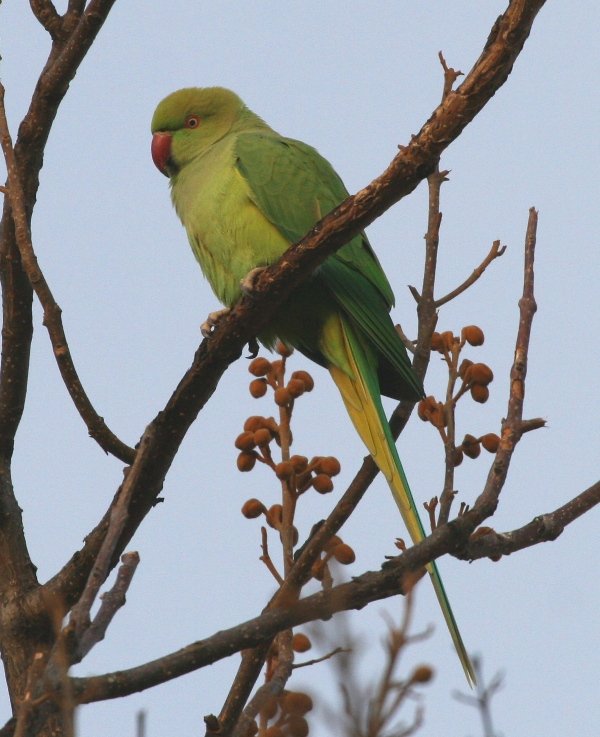
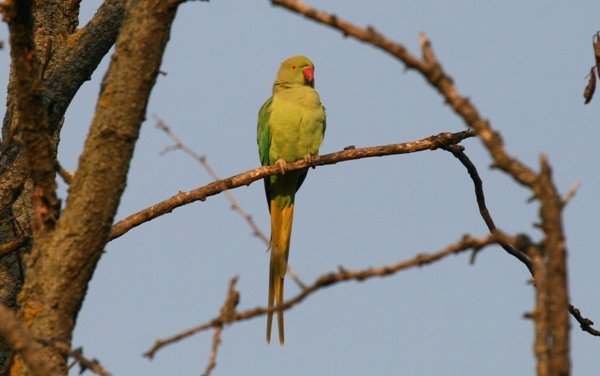
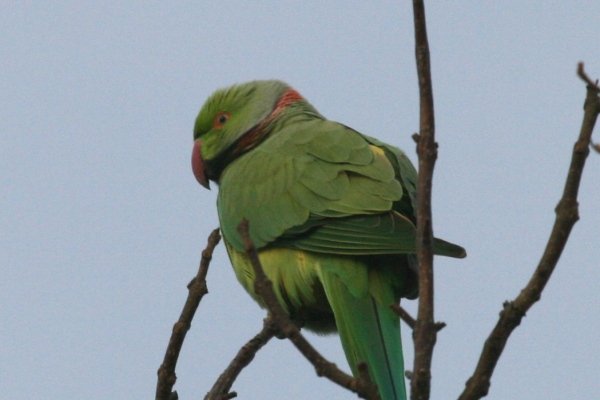

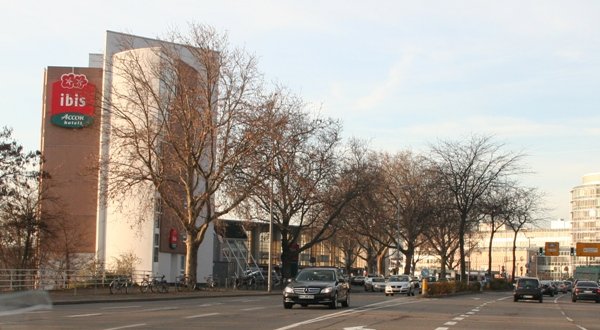
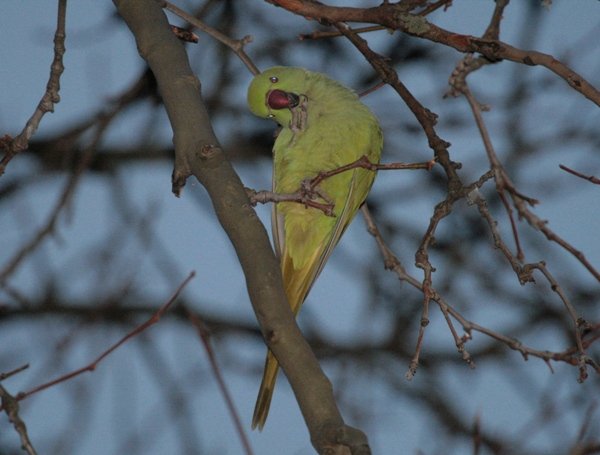
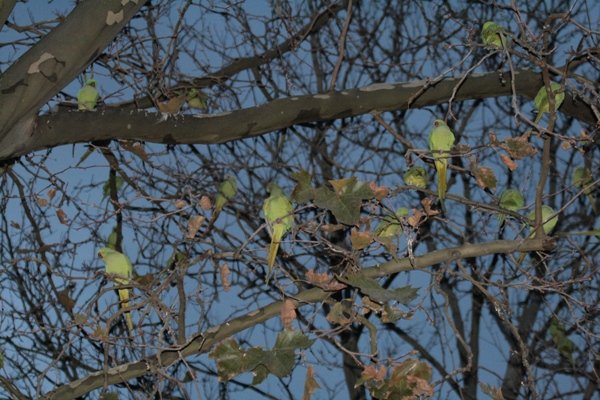
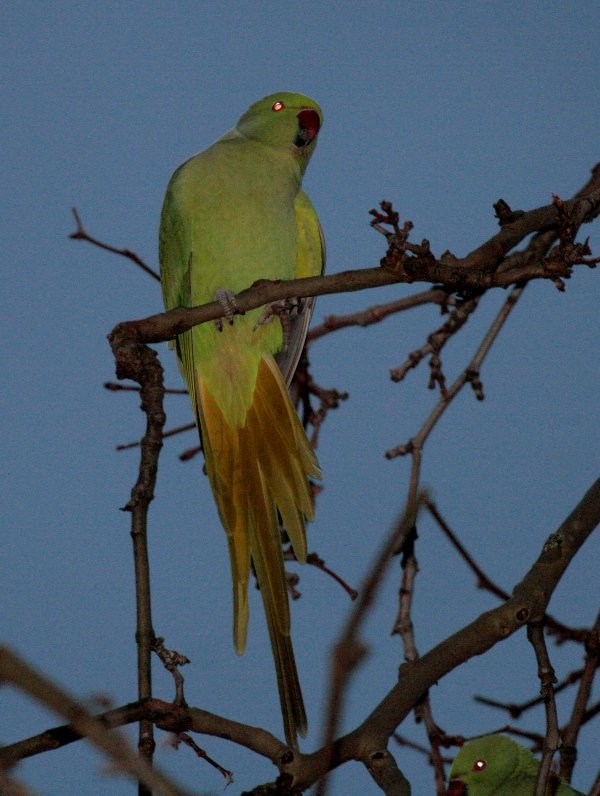
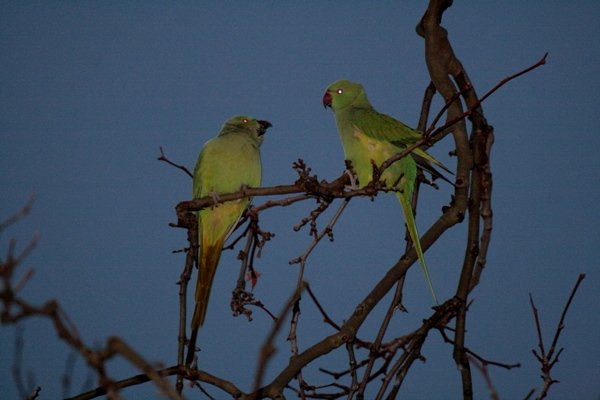











@ Jochen…for so long we have been tricked into thinking that the House Sparrow was your most colourful bird in Heidelberg and then you come up with this! What other secrets are you keeping from us all?!
If ever you are passing through London’s Heathrow Airport keep a look out for parakeets there too.
Legend has it that a few escaped from Worton Hall Studios after the filming of Humphrey Bogart and Katherine Hepburn’s African Queen.
Other stories mention pet shops burning down. Which ever the correct version may be, the Rose-ringed Parakeet is now ubiquitos in parks around the southeast of England and has been registered as an undesirable alien..
Evil! Evil! Evil!
Though they do add some nice color to your *ahem* already exciting avifauna.
@Clare: you see, for so long I have struggled to tell the parakeets from our sparrows, they are just so similar that they are extremely tough to identify. What other secrets? Who knows, once I have found out how to tell reed warblers from feral peacocks…
@Redgannet: keep a look-out for parakeets at Heathrow airport? Okay, I will. Err … what do they look like once they’ve gone through a jet engine? Any ID tips? And yes, I’ve read that even single roosts in the London area may host more than 10,000 Birds (ha! 10,000 Birds…).
@Corey: add colour to avifauna? What do color and avifauna have in common? Huh? What are you talking about?
We actually witnessed these birds while over in Heidelberg last week. We had just come out from the Ibis hotel where we were staying and the birds were flying in their hundreds over the railway station and into the trees by the taxi rank. We thought they’d escaped from somewhere, we’d never seen anything like it.
I’m delighted that I decided to look them up and for all your information on them, we don’t get things like this happening in Yorkshire! I can now inform my daughter who’s now on Heidelberg University Campus (and who’s not so delighted due to the noise they make) their story
Many thanks : )
I have seen the parakeets at the University end of Monchhofstrasse in Neuenheim. In May I saw a Buzzard over the fields by the river in Handschuhheim and in July another over Rohrbacherstrasse. Going back next week so will be looking out around the station in hope Thanks for the word on the Peregrine at Stadtwerke
First noticed them about 1988 in Thames Ditton near Esher rugby ground where they bred and multiplied into the thousands (600,000 mentioned). We recently visited Leiman near Heidleburg and immediately recognised the sound!
Wonder what will happen when they arrive in France where we now live surrounded by vineyards in the Loire Valley!
Anyone heard them around here?
Greetings from America! I came across this blog looking for where in Deutschland these birds currently reside. My grandfather’s surname was Simon. His father and grandfather were born about 120km west of Heidelberg in Saarbrucken, Saarland. Why do I mention this? The Wappen for the Simon name is two green birds that are, what you would say, a total Doppelgängerin for these adorable “Halsbandsittich”. For years I thought it was some sort of pigeon or, perhaps, a distelfink! Now, surely, for the coat of arms to exist someone needed to see these birds (which have a massive range—just Google the distribution map). The age of the Wappen is debatable but from at least the 17th century. I would think what is new to you or even the current generation is not new but, rather, history repeating itself. Unnatural things cannot happen because they are not natural.